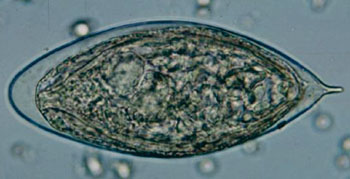Biosensor-Based Rapid Urine Test Detects Urogenital Schistosomiasis
By LabMedica International staff writers
Posted on 15 Jul 2015
In infrastructure-limited regions, point-of-care (POC) molecular diagnostics hold the potential to transform the management of infectious diseases such as schistosomiasis that carry significant long-term morbidity if left undiagnosed.Posted on 15 Jul 2015
Electrochemical biosensors are well suited for molecular diagnostics because of their high sensitivity, low cost, ease of integration into POC devices, and portability of the reader instrumentation and have now been used to detect urogenital schistosomiasis.

Image: Egg of Schistosoma haematobium in a wet mount of urine concentrates, showing the characteristic terminal spine (Photo courtesy of Centers for Disease Control and Prevention).
Scientists at Stanford University School of Medicine (CA, USA) and their colleagues have developed a strategy for a rapid one hour molecular diagnosis of bacterial urinary tract infections using electrochemical biosensors. Urinary cells are lysed and directly applied to an array of sensors functionalized with oligonucleotide probes targeting the 16S ribosomal ribonucleic acid (rRNA) of common uropathogens. Formation of the sequence-specific hybridization complex between the pathogen rRNA and the labeled capture and detector probe pairs is detected by an enzyme tag that mediates an amperometric signal output.
The biosensor is composed of three planar gold electrodes, one each for working, auxiliary, and reference. For the biosensor assay, capture probes are bound to the surface of the working electrode via a thiol linkage. Cells in the sample are lysed and mixed with a buffered solution of detector probe, then applied to the sensor surface. If the target rRNA is present, a hybridization complex of target, capture, and detector probes forms. This complex is detected by binding of horseradish peroxidase (HRP)-conjugated anti-fluorescein binding to a fluorescein tag on the detector probe and addition of tetramethylbenzidine (TMB) substrate. The electron transport mediated by the HRP is measured amperometerically, and the signal is proportional to the quantity of the target.
By inducing bulk fluid motion and local heating, alternating current (AC) electrokinetics improved overall signal-to-noise of the biosensor assay. Further implementation of electrokinetics will facilitate integration into a POC device as it obviates the need for an external incubator for hybridization. For schistosomal detection, the scientists applied square wave AC potential across the working and auxiliary electrodes of the electrochemical sensors using a function generator.
The authors concluded that they have made an important step toward development of a POC device for rapid detection of Schistosoma haematobium eggs in urine. They have implemented strategies that will aid in device integration, such as mechanical lysis and AC electrokinetics. For future development, they will integrate this core assay into a fully automated microfluidics cartridge, further optimize the detection sensitivity, and validate with clinical samples.
Related Links:
Stanford University School of Medicine













